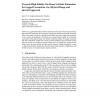Free Online Productivity Tools
i2Speak
i2Symbol
i2OCR
iTex2Img
iWeb2Print
iWeb2Shot
i2Type
iPdf2Split
iPdf2Merge
i2Bopomofo
i2Arabic
i2Style
i2Image
i2PDF
iLatex2Rtf
Sci2ools
110
Voted
ISER
2004
Springer
2004
Springer
Towards High-Fidelity On-Board Attitude Estimation for Legged Locomotion via a Hybrid Range and Inertial Approach
Legged robots display a characteristically periodic motion. Measuring and tracking this motion has traditionally been performed using general inertial measurement techniques. While widely applied in robotics, this approach is limited in dynamic legged locomotion due to the excessive accumulation of drift from severe impact shocks (nearly 9g in single leg experiments). This paper introduces the attitude estimation problem for legged locomotion and shows preliminary results from a more powerful combined range and inertial sensing approach. Based on a modified Extended Kalman Filter the method uses ground-directed range sensors, the stride period, and other periodic features of legged locomotion in order to address inertial drift. Together this provides rapid, robust estimates of flight phases and attitude necessary for extended dynamic legged operations.
| Added | 02 Jul 2010 |
| Updated | 02 Jul 2010 |
| Type | Conference |
| Year | 2004 |
| Where | ISER |
| Authors | Surya P. N. Singh, Kenneth J. Waldron |
Comments (0)

